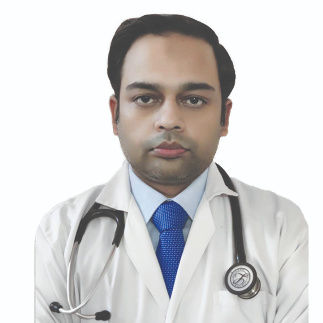Tachycardia: Types, Causes, Symptoms, Diagnosis, and Treatment
An abnormal increase in heart rate is referred to as tachycardia. Learn more about its types, causes, symptoms, diagnostic procedures, treatment, risks, and complications.

Written by
Last updated on 3rd Jul, 2025
Tachycardia is an increase in heart rate over 100 BPM (Beats Per Minute) even when the body is resting. This condition can arise from various physiological responses or underlying health issues, leading to different types and potential complications.
Keep reading to learn about tachycardia, its types, symptoms, causes, and treatment options.
Different Types of Tachycardia
Mentioned below are the different types of tachycardia:
Sinus Tachycardia
An increase in heart rate due to stress or exercise is generally called sinus tachycardia. It can also occur due to dehydration, hypovolemia (low blood volume), and certain medications. In this condition, the heart rate becomes faster but beats slowly. Exercise, fever, pain, excitement, excessive thyroid hormone secretions, etc., often lead to sinus tachycardia.
Atrial Fibrillation
Irregular or chaotic electrical signals that initiate in the atria (upper chamber of the heart) trigger the heart to beat faster in atrial fibrillation. Though it is a temporary condition, some situations may need to be treated.
Supraventricular Tachycardia (SVT)
Irregular heart rhythms starting above the ventricles (lower heart chambers) are called supraventricular tachycardia. It leads to abrupt pounding of heartbeat in multiple episodes.
Ventricular Tachycardia
It refers to the irregular rhythm of the heart that starts in the ventricles (lower heart chambers). Due to this fast rate, the heart fails to squeeze and fill the required blood to one’s body. These episodes are usually harmless and last only for a few seconds, but it can be concerning if they last more than that.
Causes of Tachycardia
The causes of tachycardia are as follows:
Electrolyte imbalance
Stress and anxiety
Fear
Fever
Anaemia
Overactive thyroid
Heart attack, heart disease, cardiomyopathy, or any other heart issues
Smoking or drinking excessive alcohol
Consuming too much caffeine
Specific medicines
Low blood in the coronary arteries, etc.
Note: Pregnancy can also cause tachycardia as it brings multiple changes in a woman’s body, including heart-related issues.
Symptoms and Diagnosis of Tachycardia
It is essential to understand the symptoms of tachycardia for timely diagnosis and treatment of this condition. In some cases, tachycardia has no symptoms; one can discover the condition only when tests are conducted for other purposes. However, the general symptoms of tachycardia are as follows:
Breathing difficulties
Fainting
Pain in the chest
Palpitations (pounding or racing heartbeat, chest flopping, etc.)
Rapid pulse
Light-headedness, etc.
Consult Top cardiologist
Diagnostic Tests and Procedures for Tachycardia
Doctors prescribe the following tests to check if an individual has tachycardia or not:
EKG (Electrocardiogram): A Holter monitor or portable machine is attached to patients’ bodies for 24 hours to record their ECG (Electrocardiogram) signals. The doctor checks the electrical activity of one’s heart to detect tachycardia.
Exercise Stress Test: Individuals need to walk on a treadmill for heart activity monitoring.
Event Monitor: It works like a Holter monitor but records at a specific time for a few minutes throughout the day. Individuals need to wear it for 30 days and push the start button upon feeling changes in heart symptoms. It can also detect changes automatically and keep records.
EP (Electrophysiological) Study: Flexible sensor detector tubes are inserted into one’s blood vessels to record the heart’s electrical signals.
Coronary Angiogram: A special X-ray or dye is used to check for narrowed or blocked blood vessels.
Tilt Table Test: If an individual faints due to tachycardia, doctors ask for this test. Here, patients' heart rhythm is recorded when they lie down on a flat table. The table is then moved up to bring the patient to a standing position, and the heart rate is recorded again to check the difference.
Besides these, doctors may also ask for tests like Magnetic Resonance Imaging (MRI), chest X-ray, and Computed Tomography (CT) scan of the heart.
Treatment Options for Tachycardia
To treat tachycardia, doctors prescribe some medicines to control one’s heart rhythm or reduce the chances of blood clotting. However, some lifestyle modifications like changes in diet, introducing stress-relieving exercises, etc., are also necessary.
Here are the effective treatment options for tachycardia:
Medications
Medicines like Digoxin, Atenolol, Verapamil, etc. are prescribed to slow heart rate down. For those with irregular heart rhythms, doctors prescribe medication like Sotalol, Amiodarone, Propafenone, etc., to maintain a regular rhythm of the heart. Some patients have a tendency to blood clotting. Medicines like Warfarin, Aspirin, etc., help prevent blood clots and lower stroke risks.
Nonsurgical Methods
Tachycardia can be treated with cardioversion and SBRT (Stereotactic Body Radiation Therapy). In cardioversion, special patches are attached to the individual’s chest to restore normal heart rhythm through a shock. However, in SBRT, a single radiation dose is used on a small part of the heart that has heart issues.
Surgical Procedure
Some surgical procedures that help treat tachycardia are as follows:
LAL (Left Atrial Appendage Ligation): In this process, the heart area with blood clotting possibility is sealed to lower stroke risks in A-Fib (Atrial Fibrillation) patients.
Cardiac Rhythm Management Device: An ICD (Implantable Cardioverter Defibrillator) or pacemaker is placed under the patient’s skin to control their heart rhythm.
Catheter Ablation
In this process, a special catheter is passed through the blood vessels of an individual’s heart. This catheter blocks the electrical pathway with hot or cold scars to normalise the heartbeat.
Risk Factors and Complications of Tachycardia
Individuals must know the risk factors for tachycardia and the complications that can develop if not treated on time.
Risk Factors for Developing Tachycardia
Here are some of the common risk factors of tachycardia:
High blood pressure
Old age
Family history
Possible Complications of Tachycardia
Here are some of the possible complications of tachycardia:
Heart failure
Getting unconscious or fainting frequently
Clotting in the blood leading to stroke or heart attack
Individuals diagnosed with ventricular tachycardia or fibrillation causing sudden cardiac death
Prevention Strategies for Tachycardia
One can prevent tachycardia by making healthy lifestyle changes and monitoring their heart health through routine follow-ups.
Lifestyle Changes
Here are some of the practices that can help tackle tachycardia:
Implementing healthy habits like regular exercise, stress management, adequate sleeping, etc.
Avoiding alcohol consumption, tobacco, smoking, etc.
Eating a balanced diet that contains low cholesterol and saturated fats
Limiting the intake of caffeine like coffee, tea, or other beverages
Staying hydrated to maintain the cardiovascular function
Monitoring and Regular Check-ups
Individuals diagnosed with tachycardia or exposed to the risks of this condition should monitor their heart conditions regularly. This includes tests like ECGs (electrocardiograms), cardiac tests for assessing heart functioning, Holter monitoring, etc.
Coping and Support for Tachycardia
Living with tachycardia is not that risky if one follows the instructions of the healthcare provider. Individuals with such conditions need to take the medications as prescribed by the doctor. If the medicine is not working accordingly, or the individual develops some new symptoms, they should contact the healthcare provider immediately.
Several support groups have emerged these days to help individuals with tachycardia cope with the condition through shared experiences and emotional support.
Conclusion
Given the potential complications associated with tachycardia, seeking professional medical advice is essential for anyone experiencing symptoms or at risk for developing this condition. Early intervention can significantly improve outcomes and quality of life for those affected by tachycardia.
Regular monitoring and adherence to prescribed treatments play a crucial role in managing the condition effectively.
Consult Top Cardiologist
Consult Top Cardiologist
Dr. Diganta Buragohain
Cardiologist
1 Years • "DM (Cardiology) in 2025 from NEIGRIHMS, Shillong MD (General Medicine) in 2020 Gauhati Medical College, MBBS in 2015 from Gauhati Medical College,"
Guwahati
Apollo Excelcare Hospital, Guwahati

Dr. Dilip Singh Rathore
Cardiothoracic and Vascular Surgeon
15 Years • MBBS, MS, M.Ch(CTVS), Gold Medalist : Minimally Invasive Cardiac Surgeon.
Bhopal
Apollo Sage Hospitals, Bhopal

Dr. Anand Gnanaraj
Cardiologist
9 Years • MBBS, MD, DM, FNB
Chennai
Apollo Speciality Hospitals Vanagaram, Chennai
(50+ Patients)

Dr. Poorna Pushkala Natarajan
Cardiologist
5 Years • MBBS, AB (INT MED), AB (CARDIOLOGY), AB (HEART FAILURE/TRANSPLANT CARDIOLOGY)
Chennai
Apollo Hospitals Greams Road, Chennai
(50+ Patients)

Dr. Arif Wahab
Cardiologist
13 Years • MD (Med.), DM (Cardio)
Delhi
Apollo Hospitals Indraprastha, Delhi
Consult Top cardiologist
Dr. Diganta Buragohain
Cardiologist
1 Years • "DM (Cardiology) in 2025 from NEIGRIHMS, Shillong MD (General Medicine) in 2020 Gauhati Medical College, MBBS in 2015 from Gauhati Medical College,"
Guwahati
Apollo Excelcare Hospital, Guwahati

Dr. Dilip Singh Rathore
Cardiothoracic and Vascular Surgeon
15 Years • MBBS, MS, M.Ch(CTVS), Gold Medalist : Minimally Invasive Cardiac Surgeon.
Bhopal
Apollo Sage Hospitals, Bhopal

Dr. Anand Gnanaraj
Cardiologist
9 Years • MBBS, MD, DM, FNB
Chennai
Apollo Speciality Hospitals Vanagaram, Chennai
(50+ Patients)

Dr. Poorna Pushkala Natarajan
Cardiologist
5 Years • MBBS, AB (INT MED), AB (CARDIOLOGY), AB (HEART FAILURE/TRANSPLANT CARDIOLOGY)
Chennai
Apollo Hospitals Greams Road, Chennai
(50+ Patients)

Dr. Arif Wahab
Cardiologist
13 Years • MD (Med.), DM (Cardio)
Delhi
Apollo Hospitals Indraprastha, Delhi



